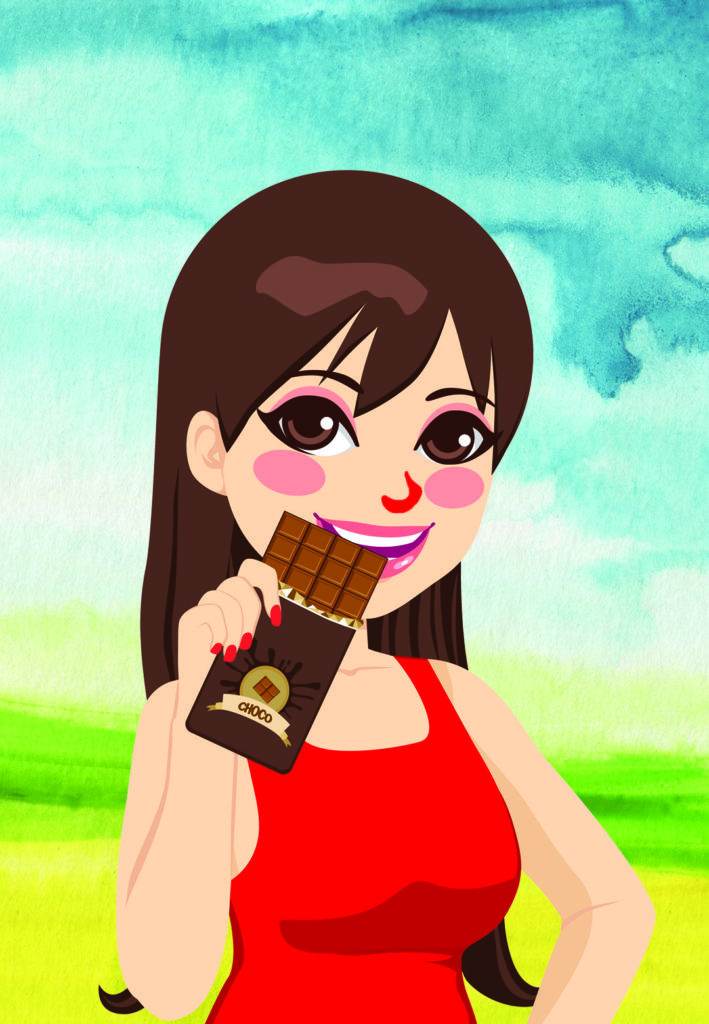BY CATOR SHACHOY
Ihave a confession to make. Pinocchio is my brother. No, I’m not made of wood. For sure, there are no strings on me. And my nose doesn’t exactly grow when I tell a lie. But the tip of my nose does get red and painful when I eat sweets. It’s true! It took not eating them to learn this was definitely happening. My nose would be perfectly fine, and then a day after eating a very innocent-looking cookie—which tasted and felt wonderful on the way down—I wished my nose were made of wood like my bro Pinocchio because then it wouldn’t hurt so much. I like sweets. Especially chocolate and cookies. In the afternoon around 4:00 my blood sugar drops, and I sure do like to get a Florentine and a chocolate chip cookie with salt on top at Peet’s—yum! I’m active and healthy, so it’s okay, right? I mean, it’s just sugar.
Last fall I went to see my Tibetan physician. She was alarmed at my inflammation level. “If you get a blood test it will show an elevated white blood cell count.”
“Really?!”
“Oh, and here—start using my antidiabetes tea. Not that you have diabetes. . .”
“You better believe I don’t!” I shot back at her playfully
After I left, what she said sank in. It was time to make some changes. I was the only one who could really make a difference on this one—my own commitment to myself. I made the choice to listen more closely to my body. I realized my nose was keeping me honest. I could no longer hide even the smallest intake of sugar. So I had a choice. Keep lying to myself or use the information I was getting wisely. My nose became my teacher. With the incentive of keeping my nose (and the rest of me) happy and healthy, I began to investigate my sugar cravings. What was I really hungry for?
When they come, they are really intense. And totally believable—I must have chocolate now! Every cell in my being wants to get up and get what I want. It’s totally legal, not harming anyone. But do I really want to become the balloon-nosed version of Pinocchio again? Knowing the repercussions, I have a stronger incentive to resist. It’s not easy to sit still and do nothing in those moments.

I began to breathe. Soften my body. Feel into what was going on. Just by creating space between thought and action, things became more workable. I felt myself calm down. An amazing thing happened: the craving passed. I was still alive, most everything was still just the same—but I didn’t have to eat that cookie. Or chocolate. Or cake. Even when people around me were eating everything in sight, somehow it was okay to say no, to practice restraint. When I could feel myself, I realized I felt better eating protein, greens, soup.
Learning to work with my sugar cravings made me wonder about other cravings—all forms of consumption. What about the “need” to buy those cute shoes? Or sweet-looking top? The sense of urgency to get it now felt a lot like gobbling something up—not so very different from eating sweets. There was the same giddy rush of satisfaction immediately afterward. But then, a few minutes later, another craving might arise, and I needed something else. So ultimately, it really wasn’t all that satisfying. Slowing down, breathing, softening—it became workable. Maybe I don’t need whatever it was after all.
What about the craving to check the news? Everyone’s ranting about the latest thing Trump destroyed. In some way, when we read the news we are taking it into our being, ingesting and consuming it. It’s not unlike eating. What does your diet consist of? And yes, the old adage still holds true—we are what we eat. How does what you consume impact your overall health and well-being? How do your body and mind feel after consumption of any sort? By applying the same approach of breathing, softening, feeling, we can become more connected to our actions and the results of our actions: “Let’s see, I bought (ate, saw, watched) that, and now I feel this way.”
Cause and effect can be seen quickly, and we can begin to make wiser choices. “Oh, I don’t want to do that again.” Staying connected to the results of our actions—how we feel in any given moment—can help us to have less regret. We don’t have to wait for it to come back around in 5 or 10 years. We know right away if this was not a good idea. And we can make a different choice. Because now we know how to practice restraint. Breathe, soften, feel. Wait for it. Allow the urge to pass. It’s gonna be okay, really.
The biggest challenge is remembering to not get caught up in the swirl of energy that says, “I must do this now!” As Ram Dass says, “Did you remember?” It takes conscious effort to put a pause between thought and action. Thoughts can be so very convincing. Learning to question thoughts before we act, we can add the little phrase: “Is that really true?” And then wait just a few minutes. Breathe. Soften. Feel. Hmmm. In the slowing down, other options appear. It takes renewed commitment. Again and again. I have more respect for Pinocchio these days. Thanks to him, my nose has taught me a deep lesson in honesty to myself.
Cator Shachoy is a craniosacral practitioner, and yoga and mindfulness instructor in private practice in SF and Berkeley. She also teaches workshops and retreats. CatorShachoy.com